In it, food writer Cherie Denham and photographer Andrew Montgomery have created a volume that goes far beyond the recipe format: yes, it is full of dishes that brim with comfort and flavour – Irish stew, Guinness cake, coddlings of sausage and potato – but it is also about people, memory and place. Through Montgomery’s luminous photography and Denham’s beautiful storytelling, The Irish Kitchen becomes both cookbook and cultural document, capturing Ireland’s warmth, resilience and evolving food heritage. Here, we delve deeper into its story with its creators – plus we feast over five recipes from within its pages.
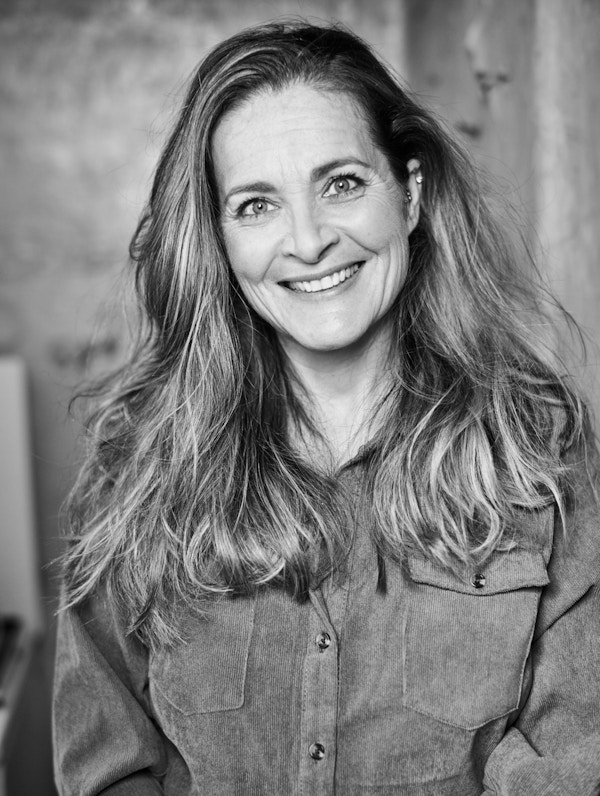
The Irish Kitchen, £30, is published on 29 October through Montgomery Press, and is available for pre-order here.
Congratulations on the launch of The Irish Kitchen, which is utterly beautiful. Can you tell us what inspired you to make it?
CD: Thank you so much! We were really touched with how incredibly well our first book, The Irish Bakery, was received. It was all based on traditional breads, tarts, tray bakes and puddings from home. Ireland has a strong baking heritage, yes, but there was so much more to explore with our food culture. We have some of the best fish in the world and slow cooked, comforting dishes like Irish Stew and Shin of Beef in Guinness. Those are everyday meals that families regularly share. It was time to explore recipes like those, that food culture and the cooking I grew up with and continue to be inspired by.
AM: I think we knew while making the first book that there were more recipes and stories to be told, obviously with the first book concentrating on the culture of home-baking in Ireland, the follow-up needed to be an expansion of that into more traditional everyday recipes. I wanted to capture more artisans and people enabling more personal stories to be told. Also I felt the need to explore more of the landscape of Ireland especially the west-coast – the new book features landscapes and stories from Achill Island, a place I have always wanted to go and photograph. Plus I wanted to celebrate and pay homage to the Irish pub -– which was not an excuse to drink more Guinness! There is a whole recipe chapter dedicated to this cornerstone of Irish culture and features some of the best documentary photography of my career, I think.
It is your second collaboration, having previously worked together on The Irish Bakery – how did it feel coming back together, this time panning out to encompass broader Irish cookery traditions?
CD: It felt like a very natural progression to be honest. The prospect of travelling around Ireland again in search of people and places was really exciting. The Irish Bakery was a very strong foundation for us. We developed a community around Irish heritage – the food and the stories. The Irish Kitchen meant we could explore small producers and artisans of vegetables, fish, meats. It was so interesting to go beyond baking and learn more about Irish food culture, while still holding on to the authenticity and warmth that so many loved in The Irish Bakery.

AM: We actually started the second book just after the publication of The Irish Bakery and so it feels like we did not really pause between the two. The second book though is bigger, not just in pages but in its visual scope. This brought challenges as so much of what was photographed was done on location – the pub recipes are shot in actual Irish pubs, the Christmas chapter is shot in a beautiful old Irish country house. In every element of the book, we pushed things visually to be as authentic as possible. I think we easily trebled the amount of work that went into the first book. I lost count of the ferry trips I made across to Belfast and Dublin and the miles driven around Ireland must be easily in the thousands!
“Ireland is a mythical place its brutal beauty is there on the west coast where the Atlantic barrels in. Against this ruggedness is the warmth of the hearth and the colour of the dresser, primary colours abound in the most unusual places across Ireland.
”
Can you tell us more about Kitty Corrigan’s contributions to the book and how that collaboration came about?
AM: I have worked with Kitty for over 20 years. We spent a lot of time together on location working for Country Living magazine on editorial shoots, she is a very talented journalist and writer with a huge knowledge of Irish culture helped, of course, by being from Omagh, Co Tyrone in Northern Ireland. In The Irish Bakery and in The Irish Kitchen we feature interviews and stories from ordinary people across Ireland, these are there to validate and hopefully inspire people as they relate directly to the recipes throughout the book. These were the recipes that they cooked and ate as they grew up in Ireland, each person having their own particular memory of baking or what the family favourites were at mealtimes.
When I first thought of the books concept, I knew that a lot of people read cookbooks at night in bed, dipping into certain pages and chapters before they fell asleep. Maybe thinking about something to cook the next day or just to look at some nice pictures or read an anecdote. I wanted to give them a little more of that content to read and connect with and so the idea of a series of personal interviews throughout the book came about. These people needed to be found, and so proper research was critical which is a real journalistic skill. Interviewing and transcribing people’s memories and words was something neither Cherie nor I could do, so we needed someone to take on that aspect of the book. The idea of featuring artisans from across Ireland was another element of both books. This was something I had spent much of my photographic career capturing along with Kitty. So she was the obvious first choice to take on this aspect of the book. Wonderfully, Kitty was recognised for her work on The Irish Bakery, winning writing awards for ‘Irish Heritage and History’ and ‘Irish Food Producers’ at the Irish Food Writing Awards.
“I lost count of the ferry trips I made across to Belfast and Dublin and the miles driven around Ireland must be easily in the thousands!
”
It’s such a visually rich book. What was your vision for how emotion and mood should come through visually?
CD: The visual direction was incredibly important to us. We wanted the book to be more than just recipes. We wanted it to be full of nostalgia and show the emotion and the quiet beauty of Irish cooking and Irish life. Andrew has incredible vision and, from the beginning, I just knew this book would be every bit as beautifully emotive as our first. He would go out early in search of locations, capture misty mornings, soft light shining through a cracked window and falling across a table in an old kitchen – all the little moments that give the photographs their story. For me, each shot in the book is full of authenticity and tells a story. We want our readers to feel a connection to the slow pace of life, the traditions and the beauty in the landscapes.
AM: Emotion and mood is something that photographs are able to capture in a very unique way. Being a still image, it contains a moment frozen in time. To create and observe those moments, you need to understand light, which is directly related to mood and atmosphere – ask any cinematographer or visual artist. Time of year is one ingredient. The mood and atmosphere of late winter light is haunting. The same subject shot in summer becomes something else, while the saturated greens of spring can dominate where the line and silhouette of a winter scene can bring something more subtle and beguiling. Ireland is a mythical place, its brutal beauty is there on the west coast where the Atlantic barrels in. Against this ruggedness is the warmth of the hearth and the colour of the dresser – primary colours abound in the most unusual places across Ireland. These visual elements come together in the book, sometimes emphasised through the use of black and white photography; other times more muted colour pallets feature. This tableau of imagery in its whole is what Ireland is to me. The marks of time, faded colour on a pub door, a golden sunset, the kettle on the hob all come together as a whole within the pages. The subtle quality of light is the magic glue that holds all of this together, for me that magic light is something Ireland has in abundance. Many included recipes are time-honoured, like Irish stew and treacle farls, alongside more modern interpretations.
“More and more small producers and artisans are starting new businesses, and their produce is fantastic, shaped by seasonality, new ideas and what is around their local area.
”
How did you balance tradition with contemporary creativity?
CD: We wanted the book to reflect how great Irish food is and, although the foundation of traditional recipes is brilliant and solid, Irish food is always evolving. More and more small
producers and artisans are starting new businesses, and their produce is fantastic, shaped by seasonality, new ideas and what is around their local area. Our book was not about reinventing old recipes for the sake of it, it was more about whether these recipes really had stood the test of time and how they were still being cooked in people’s homes and small restaurants.
Was there a particular regional ingredient or local artisan story that surprised or inspired you most during your travels across the island?
CD: Yes, meeting Stevy & Rachel and their curly pigs in Co.Fermanagh, N.Ireland, was one of the most memorable parts of our journey. Originally, they didn’t think about being charcuterie producers at all. They bought one Mangalitsa pig, with curly, woolly hair to help clear scrub land on his farm as they couldn’t afford heavy machinery. The Mangalistas are natural foragers, so they got to work efficiently and organically rooting through the undergrowth. Stevy said that as he spent more time with the pigs, learning their habits and understanding them, something changed and he gained huge respect for them. He started experimenting with traditional curing methods and, before long, he started a small charcuterie business. Organic, ethical and so delicious!
AM: From a visual point of view, I really loved Carlingford Oysters, the huge estuary where the Oyster beds were located were spectacular at low tide. There is a big landscape photograph in the book showing a convoy of specially modified tractors rolling out onto estuary with their trailers carrying the workers, all back-lit against the morning sun. It reminded me of something out of the old American west. Interestingly I think that Wild-West visual iconography is recurring theme through-out the book both in the landscapes and portraits I shot.
Beyond recipes, your book includes interviews with producers, folklorists, and storytellers. How important was weaving those human and cultural stories into the kitchen narrative?
CD: It was just so lovely that this aspect of the book was so well received in our first book and carried on through The Irish Kitchen. This was all Andrew’s idea, he has the most brilliant vision. Irish food is shaped by the land, the people and the stories passed down and shared around kitchen tables. The readers had to know about this wonderful foundation. When you hear Margaret Gallagher talk about her mother making soda bread over the fire but having to make sure the wind wasn’t blowing a certain way or it would ruin the heat of the fire or Michael the folklorist explain how Colcannon was served to visitors in a cabbage leaf at Halloween, the stories give these foods made with humble ingredients a sense of community and love. Behind every dish in this book is a memory.
“There is a big landscape photograph in the book showing a convoy of specially modified tractors rolling out onto estuary with their trailers carrying the workers, all back-lit against the morning sun. It reminded me of something out of the old American west.
”
What do you hope readers will feel or learn about Irish hospitality after flipping through these pages, whether in the pub, the pantry, or around the Christmas table?
CD: We just hope that our readers feel the genuine spirit of warmth and generosity that is Irish hospitality. It’s humble and giving! It’s the kind that as soon as you step through the door, the kettle is put on the stove, a cake or tea loaf is put on the table and, before you’re sent off with a ‘safe home’, something homegrown or homemade is packaged up and put into your hands. The pantry was always kept well stocked and at Christmas stories are shared by the fire with a tipple of something warming and songs are sung around the piano. This is how it was on Christmas night for me. If someone came to the door, room was always made and good and drinks were always offered with simplicity and love. The pub is about connection. When we went to Glin, we saw that the pub was opened at 10am in the morning for members of the community to come together, not necessarily to drink but to feel a sense of community and belonging. If our readers feel even a glimmer of that spirit and sense of belonging, that’s a grand job!
Can you share a favourite memory from your travels around Ireland gathering recipes or photographing kitchens?
CD: One moment that really stands out for us both was on a rainy afternoon in Limavady,
N.Ireland. We drove down off the main road and down a farm track. There was an old farm
worker’s cottage on the edge of the track. We unlocked the very stiff door and Andrew put his shoulder to the door, as soon as we set foot inside the atmosphere hit us! We were standing inside the front cover of our book! We could feel the history of this cottage, there was the most wonderful peaceful aura and the sunlight streaming through the kitchen window and net curtains beside the fireplace was golden. The old wooden stove stood proud on the tiled hearth and that moment confirmed to us why we were putting so much time and effort into our book. It was a deeply sensory memory, an atmosphere we tried to carry through every page of the Early Mornings Chapter. It was a quiet kind of magic that wasn’t planned and you never forget.
AM: This was the stand-out moment for me as well and Cherie is absolutely right about the atmosphere and warmth within those little rooms. Also witnessing first-hand the worst storm to hit Ireland in century was another. We had no heating or power for several days at the location we were at, having no choice to carry-on and venture out to reach certain locations was slightly apocalyptic at times, with fallen trees everywhere and outbuildings raised to the ground. Everyone was told to stay in-doors and not venture out, which we tried to stick to but inevitably gave in and got in the car!
“We know how much she loved The Irish Bakery, so to hear her say she thinks she likes The Irish Kitchen even better is wonderful, very high praise indeed!
”
The great Diana Henry said the book was ‘genuine, very well-judged and structured, with fabulous photographs.’ What does that praise mean to you personally, especially following that first book?
CD: Reading those words from Diana Henry meant the world to us, not only because of how highly she’s respected in the world of food but because of how she sees food. Diana, like me, is originally from N.Ireland, so that also means so very much to me. She has such a wonderful ability to capture the emotion and culture of cooking and to speak so poetically about it. I also know that Diana is incredibly genuine and speaks from the heart and if she doesn’t believe in something, she won’t do it. We know how much she loved The Irish Bakery, so to hear her say she thinks she likes The Irish Kitchen even better is wonderful, very high praise indeed!
AM: It’s a validation, Cherie and I know how good we think the sequel is, we know what went into making something that is bigger and better, the effort needed to go beyond what went before. Diana Henry is one of the most respected and talented people in the editorial and culinary world – for her to be so generous in her praise is something both Cherie and I are very proud of as we know not all cookbooks are received in the same way.
If you had to choose a desert island dish from the book, what would be the one you saved from the waves?
CD: I absolutely love bread, it’s in my DNA – as long as I had bread and salted butter, I’d be grand. The Guinness Wheaten Bread is so easy and captures the essence of The Irish Kitchen, real, traditional and comforting. Oh, if I could add my Spiced Crab Apple and Rosehip Jelly too that would be wonderful!
AM: Well for me it’s cake! Why do you think I wanted to make a baking book!! My absolute
favourite is the Guinness Cake. Hands-down every time, that dense malty texture cut through with the frosty cream-cheese topping. I might need a pot of tea alongside though to wash it down!
Finally, what’s next for you? Can we expect to see any more collaborations in the pipeline?
AM/CD: Yes definitely we have more collaborations in the pipeline. We have begun work on our third book – which will be quite different to The Irish Bakery and The Irish Kitchen as we feel we have encompassed the things we wanted to say in those two volumes. We may take a little longer in its production and process as time is in many ways the most important aspect to making something really worthwhile.
Take 5: Recipes From The Irish Kitchen
GLENILEN PORRIDGE WITH MAPLE AND HONEY GRANOLA AND ROASTED PLUMS
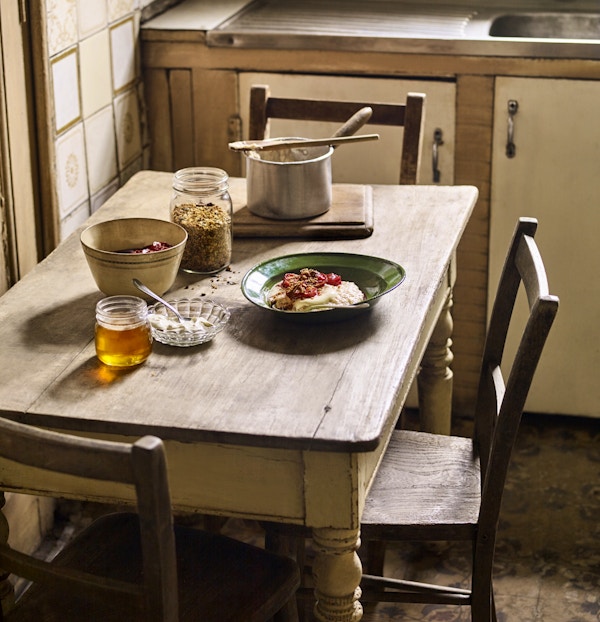
Nestled in the rolling green hills of County Cork lies Glenilen Farm, owned by Alan and Valerie Kingston. Val’s porridge is the stuff of legends. She serves it with fresh homemade granola, Glenilen yoghurt, homegrown fruit stewed to perfection and local honey to drizzle all over it. The porridge is thick and creamy and the warm, toasted granola, full of sultanas (golden raisins), nuts and seeds is served in a large earthenware bowl. The stewed fruits, as Val said, are ‘always seasonal and whatever is growing’. It was a breakfast to remember! This is my version of Val’s delicious granola. Don’t pulse the nuts for too long or they will burn easily in the oven. Add whatever nuts and seeds you like – just make up to the quantity in the recipe. You can also add sultanas and dried cranberries once the granola is cold – optional, but advisable! This recipe makes more granola and plums than you’ll need for the porridge.
Serves 2
For the maple and honey granola
– 500 g (1 lb 2 oz/5 cups) rolled oats
– 110 g (4 oz/ 3/4 cup) whole raw almonds
– 110 g (4 oz/generous 1 cup) pecans
– 110 g (4 oz/ 3/4 cup) blanched hazelnuts
– Large pinch of sea salt flakes
– 225 g (8 oz/scant 2/3 cup) runny honey
– 110 ml (4 fl oz/scant 1/2 cup) maple syrup
– 55 ml (2 fl oz/ 1/4 cup) rapeseed (canola) oil
– 55 g (2 oz/ 1/3 cup) chia seeds
– 110 g (4 oz/ 2/3 cup) golden linseeds
– 85 g (3 oz/ 2/3 cup) sunflower seeds
– 85 g (3 oz/ 2/3 cup) pumpkin seeds
– 1 tablespoon ground cinnamon
– Rapeseed (canola) oil, for greasing
For the roasted plums
– 12 firm plums, halved and stoned
– 85 g (3 oz/ 1/4 cup) honey
– 85 ml (3 fl oz/ 1/3 cup) maple syrup
– 2 teaspoons vanilla bean paste
For the porridge
– 85 g (3 oz/generous 3/4 cup) rolled oats
– 550 ml (181/2 fl oz/21/3 cups) cold water or milk, or a mixture of both
– Pinch of sea salt flakes
To serve
– Thick yoghurt
– Honey
First, make the granola. Preheat the oven to 180°C fan (400°F/Gas 6) and grease a large roasting tin. Pour the oats into a large bowl. Pour the nuts into a food processor and pulse until roughly chopped. Add the nuts and the salt to the oats and mix together, then stir in the honey, maple syrup and oil. Mix well, ensuring all the dry ingredients are coated. Pour the mixture into the roasting tin and bake in the oven for 15 minutes. Remove from the oven and stir, then continue baking for a further 10 minutes. Finally, stir again, then bake for 5 minutes. You may need a couple more minutes if you like your granola well toasted and golden brown. Do keep an eye it, though, so it doesn’t burn. Remove the granola from the oven (don’t turn it off) and pour in the seeds and cinnamon. Stir well and leave to cool completely, then store in glass jars for up to 6 weeks. Next, make the roasted plums. Place the plums snugly in an ovenproof dish, in a single layer. Drizzle over the honey, maple syrup and vanilla bean paste. Roast in the oven for 20 minutes, then remove from the oven and baste the plums in the juices before returning to the oven for a further 10–20 minutes, or until the plums are soft and have released their juices. Now make the porridge. Put the oats into a saucepan, pour in the water or milk and sprinkle in the salt. Bring to the boil, then simmer for 3–4 minutes, stirring continuously until the porridge thickens. Divide the porridge between bowls, scatter with granola and top with some of the plums, a spoonful of thick yoghurt and a drizzle of honey. Note. The granola can be kept in an aitright container for up to 3 months and the plums can be stored in the refrigerator for up to 1 week.
TURFCUTTER’S OMELETTE
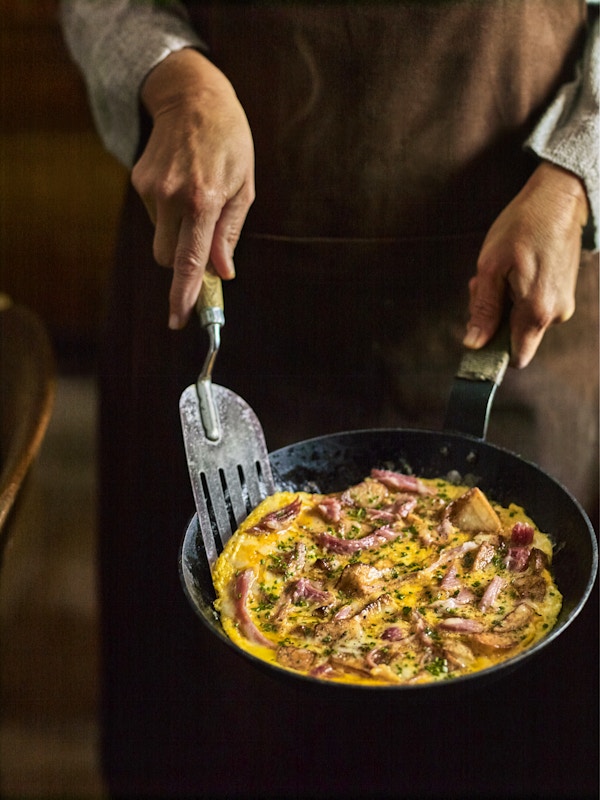
Turf fires are the smell of Ireland. Consisting of layers of ancient vegetation, turf is peat cut from the Irish bog. It is used as a solid fossil fuel the length and breadth of Ireland. On Achill Island, the smell of turf fires hung in the air as we shot on location. Cutting turf is hard work and it can only now be cut for personal use to preserve the ancient fuel. Often my Granny would go out to the bog with Granda and they’d cut turf for the cold months ahead. A nourishing and filling breakfast was needed before such heavy work. This is a great way of using up leftovers. Don’t let the eggs cook too quickly as it will toughen them. Move your spatula slowly from the sides into the middle as this helps the egg to cook evenly.
Serves 2-4
– 30 g (1 oz) unsalted butter
– 1 tablespoon rapeseed oil
– 450 g (1 lb) cooked potatoes, cut into 3 cm (11/4 inch) chunks
– 140 g (5 oz) ham hock or thick-cut ham, shredded and finely chopped
– 4 medium eggs, beaten
– 55 g (2 oz) Irish cheddar, grated
– 1 tablespoon finely chopped chives
– Sea salt and freshly ground black pepper
Heat the butter and oil in a large frying pan over a medium heat. Add the potatoes, then season with salt and pepper and fry slowly for 10–15 minutes until lightly golden. Add the ham and fry off for a minute or so. Pour over the eggs, then use a spatula to drag the egg into the middle of the pan until almost cooked. Scatter over the cheese and chives, then fold the omelette over in half and cook until the cheese has just melted. Remove from the heat, slice in half and serve
DUBLIN CODDLE WITH BLACK BACON
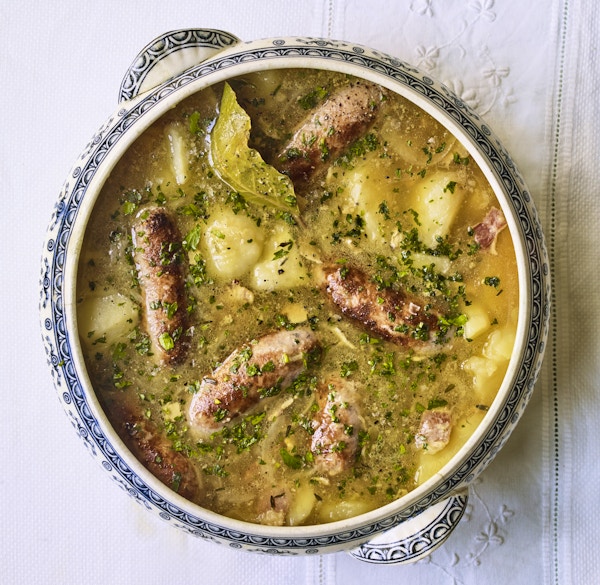
Knowing that a pot of coddle is gently simmering on top of the stove or cooking low and slow in the oven while you go about your day is a very comforting thing. Years ago, coddle was put on in the morning and by the evening, after slow cooking all day, it was ready for the family’s evening meal. It’s easy to underestimate something as simple as coddle, but when the smell starts to emanate from the pan, you’ll understand that just a few simple ingredients are all that is needed to make a truly delicious, homely dish. Traditionally, the onions, bacon, sausages, carrots and potatoes and stock were all combined and boiled, which creates a pale stew. Parsley was added to give a bit of colour. I prefer my coddle with colour, so I brown my sausages first, which makes it look much more appealing. Some people also like to add pearl barley. Black bacon is made by Pat O’Doherty in Enniskillen, County Fermanagh. It’s made from outdoor-raised, rare-breed pigs that are boated over to Innishcorkish Island to feed on the local herbs and vegetation on the island. The bacon gets its name and colour from a traditional curing and smoking process. The black refers to the deep, dark outer crust that the bacon gets after being cured, smoked and matured. Sugar, treacle and molasses are used in the curing mix. It’s cold-smoked over hardwoods, which gives it a dark, rich surface. In our house, we enjoy our coddle with a Guinness and slices of soda bread, lovingly slathered with butter
Serves 8
– 2 tablespoons rapeseed (canola) oil
– 225 g (8 oz) smoked streaky (side) bacon, sliced
– 600 g (1 lb 5 oz) pork sausages
– 2 onions, thinly sliced
– 15 g (1/2 oz) unsalted butter
– 2 tablespoons finely chopped thyme
– 1 kg (2 lb 4 oz) potatoes, peeled and cut into 4 cm (11/2 inch) chunks
– 1.5 litres (50 fl oz/61/3 cups) ham or chicken stock
– 2 bay leaves
– 2 tablespoons chopped parsley
– Sea salt and freshly ground black pepper
Heat 1 tablespoon of the oil in a frying pan over a medium heat and fry off the bacon until nicely coloured, then transfer to a casserole dish (Dutch oven). Next, brown the sausages all over until they’re evenly coloured, then transfer them to the casserole dish too. Add the onions to the pan with the remaining oil and the butter. Soften over a low heat for about 10 minutes until they’re golden and sweet, then stir in the thyme. Add to the casserole dish. Add the potatoes to the dish and cover with the stock. Bring to the boil, then reduce to a simmer. Cook for 45–60 minutes, or until the potatoes are soft and falling apart, thickening the coddle. Taste and adjust the seasoning, then stir in the parsley and serve
GUINNESS SCONES
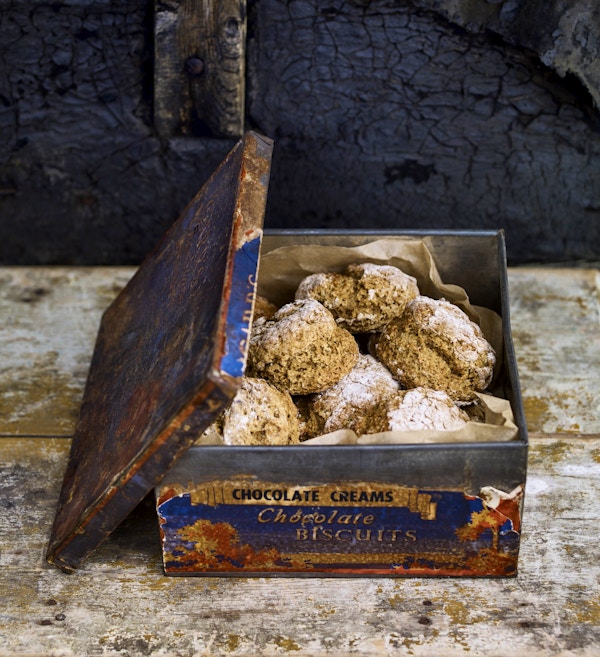
The day after our fantastic book launch for The Irish Bakery, Andrew, our friend Rups and I all headed to County Cork for a book event. We had a five-hour journey in front of us and had a few stops along the way. One of our stops was a little café in Kildare. We all ordered takeaway teas and, as we were about to leave, Andrew spotted Guinness scones. I have to be honest, I’d never seen Guinness scones before, but Andrew had to have one. He said that they had to be in our next book, so when on Achill Island, Andrew went out looking for locations to shoot the scones while I baked them. The next day, on the road back up to the north, we enjoyed the leftovers sandwiched together with butter, Irish cheddar and my Tomato and Apple Chilli Chutney.
Makes 7 scones
– 285 g (10 oz/21/4 cups) self-raising (self-rising) flour
– 30 g (1 oz/scant 1/4 cup) wholemeal (whole-wheat) flour, plus extra for dusting
– 1 teaspoon bicarbonate of soda (baking soda)
– Pinch of sea salt
– 30 g (1 oz) unsalted butter
– 55 g (2 oz/generous 1/4 cup) dark brown soft sugar
– 1 medium egg, beaten
– 1 tablespoon black treacle (molasses)
– 85 ml (3 fl oz/ 1/3 cup) Guinness
– 30 ml (1 fl oz/2 tablespoons) buttermilk
Preheat the oven to 200°C fan (425°F/Gas 7) and dust a baking sheet with flour. Pulse the flours, bicarbonate of soda, salt, butter and sugar in a food processor until the mixture resembles breadcrumbs, then pour into a bowl. Alternatively, you can do this in a bowl with your fingers. Using a hand mixer, gently blend the egg, treacle, Guinness and buttermilk together. Stir this into the dry ingredients to form a dough. Turn out onto a lightly floured surface and bring the dough together gently – don’t be heavy handed, as you want to keep all of that air in, so the scones stay light. Pat the dough and roll it out to 2.5 cm (1 inch) thick. Dip a 6.5 cm (21/2 inch) pastry cutter into some flour and stamp out the scones. Keep the pastry cutter well-floured so it doesn’t stick. Once all the scones have been stamped out, place them onto the baking sheet and sprinkle the tops with wholemeal flour. Bake on the top shelf of the oven for 10 minutes. Remove from the oven and transfer to a wire rack to cool.
SHERRY TRIFLE WITH RASPBERRIES, VANILLA CUSTARD AND TOASTED ALMONDS
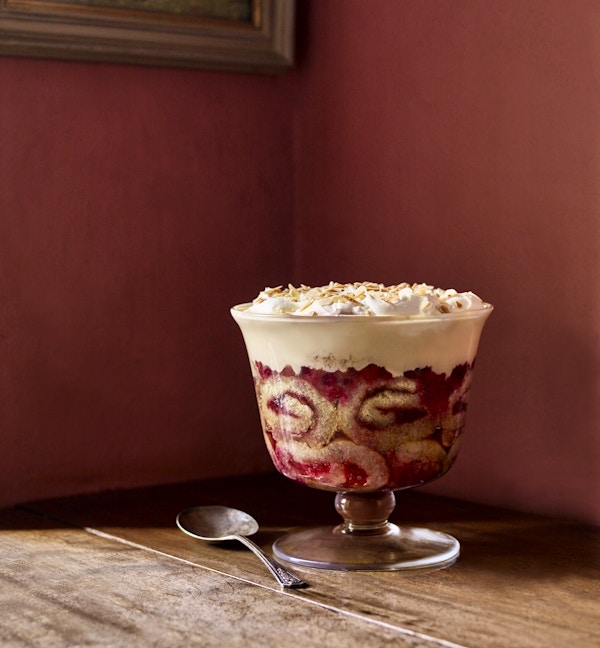
In the run-up to Christmas, when Mummy would be in bed on a Sunday after a busy Christmas night duty at the hospital where she worked, I’d be in charge of making the sherry trifle. Auntie Evelyn made the best sherry trifle, always crowned with freshly whipped cream and toasted almonds, so I based my recipe on hers. She used frozen raspberries from the summer. As they defrosted, the juices mixed with the sherry and soaked into the sponge. Trifle is such a versatile pudding and can be made in advance in one large bowl or lots of small bowls. The fruits can be a variety and either fresh or frozen and the cake can be leftovers or a Swiss (jelly) roll, Madeira cake or Victoria sponge. For me, though, the alcohol must be sherry. Traditionally, Auntie Evelyn never put jelly in her sherry trifle, so I don’t either. Scatter over the toasted flaked almonds just before serving the trifle, otherwise they’ll lose their crunch. Top tip: toast lots of nuts and freeze the ones you don’t need.
Serves 10
– 900 g (2 lb) frozen raspberries, defrosted (reserve the juices)
– 85 g (3 oz/ 1/3 cup) caster (superfine) sugar
– 1 jar of raspberry jam (about 350 g/ 12 oz)
– 200 ml (7 fl oz/scant 1 cup) sweet sherry
– 300 ml (10 fl oz/11/4 cups) double (heavy) cream, lightly whipped
– 30 g (1 oz/ 1/3 cup) flaked (slivered) almonds, toasted For the custard
– 300 ml (10 fl oz/11/4 cups) whole milk
– 300 ml (10 fl oz/11/4 cups) double (heavy) cream
– 4 medium egg yolks
– 2 teaspoons vanilla bean paste or extract
– 85 g (3 oz/ 1/3 cup) caster (superfine) sugar
– 2 tablespoons cornflour (cornstarch)
For the sponge
– 3 medium eggs
– 85 g (3 oz/ 1/3 cup) caster (superfine) sugar, plus extra for sprinkling
– 1 teaspoon vanilla bean paste
– 85 g (3 oz/ 2/3 cup) self-raising (self-rising) flour
First, make the custard. Pour the milk and cream into a large saucepan over a medium heat. Bring to a simmer, then remove from the heat. Whisk the egg yolks, vanilla, sugar and cornflour together in a large bowl until combined. Pour a little of the hot cream mixture over the egg mixture, whisking continuously. Don’t add it all at once or the eggs could scramble. Add the remaining cream and stir to combine. Clean out the pan and pour the mixture back in. Cook over a medium heat, stirring continuously, until the custard thickens. Remove from the heat and cover with dampened baking parchment to prevent a skin forming. Set aside to cool.
Now make the sponge. Preheat the oven to 180°C fan (400°F/Gas 6) and line a 26 x 36 cm (10 x 14 inch) Swiss (jelly) roll tin with baking parchment. In a large bowl, whisk together the eggs, sugar and vanilla paste for 10–12 minutes until pale and fluffy. Sift the flour lightly over the mixture and gently fold in using a large metal spoon until you can’t see any more flour. I turn the bowl as I fold. Pour the mixture into the prepared tin and bake for 8 minutes. The sponge should be golden and springy to the touch. Place a sheet of baking parchment on your work surface and sprinkle it all over with caster sugar. Turn out the warm sponge onto the sugared paper and cover with a damp dish towel for 5 minutes. Remove the dish towel and carefully peel away the baking parchment from the sponge. Use a knife to carefully score a line about 2 cm ( ¾ inch) in from one of the short sides of the sponge. Using the paper to help you, roll up the sponge, then set aside to cool with the seam facing down. Strain the raspberries and pour the juice into a small saucepan, then add the sugar and place over a medium heat. Bring to the boil and cook until thick and syrupy. Remove from the heat, mix with the raspberries and set aside to cool.
When the sponge is cool, gently unroll and spread with the jam, then re-roll and wrap in the parchment paper to keep its shape. When you’re ready to assemble, slice the sponge roll and arrange some in a trifle bowl. Drizzle over some of the sherry and spoon over some raspberries. Continue these layers until everything has been used. Pour the custard on top, then cover with the whipped cream. Scatter over the almonds before serving.





